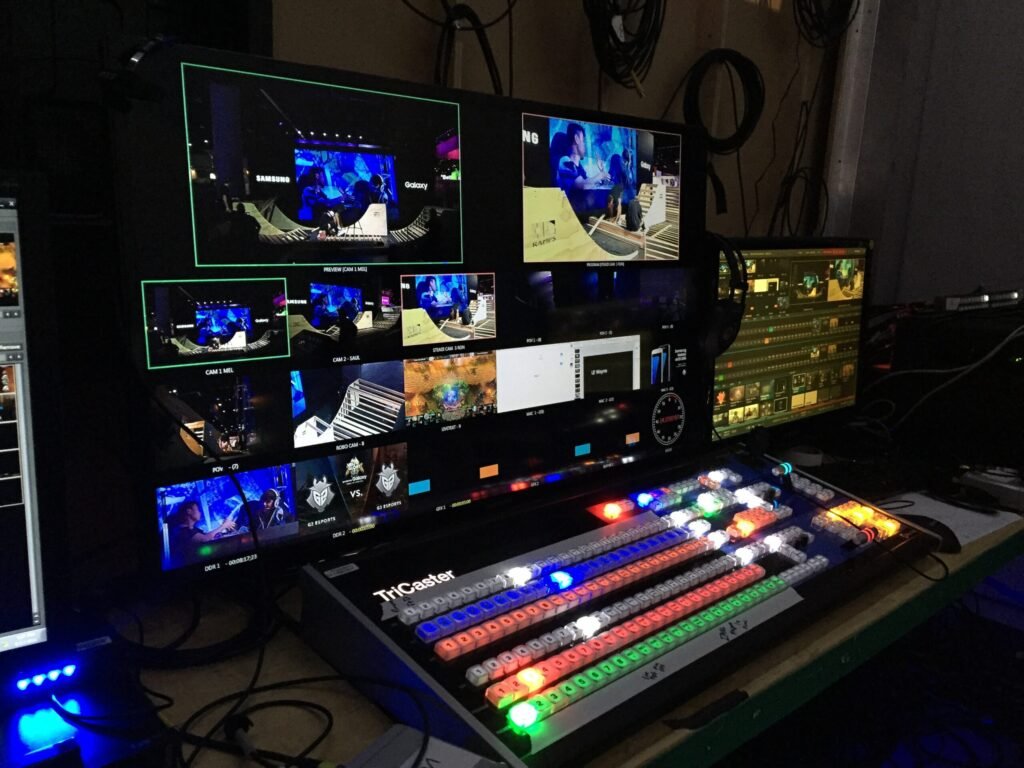Why Build an Immersive Shared Reality (ISR) Experience Today?
A Strategic Framework for the Future of Entertainment
The Immersive Shared Reality (ISR) space is rapidly moving from “wow-factor” proofs-of-concept to a powerful, revenue-generating platform. Global immersive-entertainment revenues are projected to hit USD 426 billion by 2030, growing at a staggering 24.6% CAGR [4]. This is a clear sign that audiences, brands, and studios are all looking for the next “big screen.”
Pioneers like COSM are already proving the model. Their 12K-LED domes in Los Angeles and Dallas are being positioned as premium venues for blockbuster IP (like The Matrix) and live-sport experiences, with plans to add five more screens in the next two years.
Below is a comprehensive question framework to help you articulate why you should invest, design, and launch a new ISR offering. Each section is paired with real-world insights from COSM’s launch to show how these questions shape a winning strategy.
| Question | Why it Matters | COSM-Specific Insight |
|---|---|---|
| What core problem are we solving for the audience? (e.g., “ordinary cinema feels passive”) | Clarifies the emotional hook that justifies a new format. | Cosm’s pitch is that viewers “go with Neo, experiencing the journey like never before” — turning a film into a shared adventure [1]. |
| How does ISR amplify the story/brand better than 2-D or head-mounted VR? | Ensures the technology adds narrative value, not just spectacle. | The Matrix is re-imagined as a “shared reality” experience that extends the on-screen world into the 87-ft dome, surrounding the audience [1]. |
| What long-term ecosystem are we building (content pipeline, partnerships, recurring visits)? | Shows sustainability beyond a one-off event. | Cosm already has a multi-film partnership with Warner Bros. and plans to expand to sports, concerts, and other IPs [1]. |
| Question | Key Data to Gather | COSM Example |
|---|---|---|
| Who is the primary audience (age, gender, interests, location)? | Age bracket, fandom affinity, willingness to pay. | COSM’s FAQs list an age restriction for the Matrix event (18+), indicating a target of adult-centric fans and tech-savvy Millennials/Gen-Z [2]. |
| What secondary segments could be attracted (corporate groups, tourists, families)? | Potential B2B revenue streams, weekday traffic. | COSM promotes group-event hosting and a “sports-bar” hall, hinting at corporate & casual-entertainment markets [2]. |
| What is the geographic footprint of our early adopters? | City size, cultural hubs, disposable-income metrics. | Current venues are in Los Angeles & Dallas—two large media/tech markets with plans for Atlanta, Detroit, Cleveland [2]. |
| What is the audience’s price elasticity? | Ticket-price benchmarks, bundle uptake. | Premium tickets range from $30-$35 (weekday NBA) to >$1,000 (Super Bowl packages); immersive-film tickets have topped $50 [1]. |
| Stakeholder | Question | Answer Focus |
|---|---|---|
| Audience | What unique experience do we deliver that can’t be replicated at home? | Full-surround 12K LED dome, no headset, communal “be-there” feeling. |
| Content Owners (Studios) | How does ISR open a new revenue channel and extend IP longevity? | Revenue-share model (ticket split) + extended-life for classic titles (Matrix 25-yr anniversary). |
| Venue Owners / Investors | What incremental revenue per square-foot does ISR generate vs. traditional cinema? | Higher ticket price tiers, longer dwell time (food, merch, bar), multi-use space. |
| Advertisers / Brands | What activation formats are possible in a 12K-LED environment? | Dynamic ad-inserts, branded virtual scenery, product placement visible to an entire dome audience. |
| Question | Purpose | COSM’s Edge |
|---|---|---|
| Who are the direct competitors (ScreenX, 4DX, VR arcades, IMAX)? | Benchmark pricing, tech, capacity. | Cosm uses LED-dome “shared reality” with no headsets, larger visual field than ScreenX’s side-walls. |
| What are the barriers to entry for newcomers? (hardware cost, IP deals, content pipeline) | Assess sustainability of advantage. | 12K-LED dome cost ≈ $10–15 M each; COSM already secured $250 M funding and key studio partners [1]. |
| How can we protect our IP/experience (patents, exclusive studio deals)? | Legal defensibility. | Cosm’s multi-film partnership with Warner Bros. creates exclusivity for premium releases. |
| Question & Key Considerations | |
|---|---|
| Which genres/IPs drive the highest ISR attendance (sci-fi, action, sports, music)? | Data from ticket sales, social listening. |
| How will we source and adapt content (in-house VFX, third-party studios)? | Cosm co-created the Matrix experience with Little Cinema [1]. |
| What is the renewal cadence for new experiences (seasonal, anniversary, live-event)? | Plan a calendar that mixes evergreen titles with live sport seasons. |
| What licensing terms are required (revenue share, exclusivity, duration)? | Warner Bros. deal includes ticket-revenue split [1]. |
| Question | Answer Focus |
|---|---|
| What are the technical specs of the LED dome (resolution, brightness, latency, tracking)? | 12K LED, 87-ft diameter, real-time CG injection. |
| How will we integrate live-camera feeds, motion-capture, and pre-rendered CG? | Pipeline that maps CG to dome geometry in sync with film frames. |
| What is the OPEX per screen (energy, staff, maintenance) and how does it scale to 5 new venues? | Build a cost model per dome; factor in redundancy and remote monitoring. |
| What redundancy / backup systems are required to avoid downtime during premium events? | Redundant power, hot-swap LED panels, on-site VFX crew. |
| How does the architecture support future upgrades (AR overlays, interactive haptics)? | Modular projection stack and open-API for third-party AR SDKs. |
| Revenue Stream | Question | Typical COSM Figures |
|---|---|---|
| Ticket Sales | What price tiers and bundle options maximize occupancy and ARPU? | Premium film tickets > $50, sports packages $30-$35, high-end events $1,000+ [1]. |
| Food & Beverage | What average per-guest spend can we achieve? | Bar & lounge areas (The Deck) encourage “no bad seat” dwell time [2]. |
| Merchandise | Which branded items sell best in an ISR context? | Matrix-themed apparel, collectible lenses, venue-branded LED-wearables. |
| Sponsorship / Branded Content | What activation formats suit a 12K dome? | Dynamic LED-wall ads, virtual product placement inside the CG extension. |
| B2B Rentals | What pricing model for private bookings? | Group-event packages, corporate-retail partnership fees. |
| Revenue Sharing with Studios | What split percentages are standard? | Cosm’s model uses ticket-revenue sharing with Warner Bros. [1]. |
| Question | Data Needed |
|---|---|
| What is the total CAPEX per dome (LED panels, infrastructure, build-out)? | Typical 12K-LED dome ≈ $12M (industry benchmark). |
| What is the break-even attendance rate per show (capacity × avg ticket price)? | Example: 800 seats × $50 = $40k per show; need X shows/month to cover OPEX. |
| How does the projected cash-flow change with the addition of 5 new screens? | Create a phased model: Year 1-2 (2 domes), Year 3-5 (7 domes). |
| What financing sources (equity, debt, strategic investors) are available? | Cosm raised $250M last summer [1] — indicates investor appetite for ISR. |
| Sensitivity analysis — what if ticket price drops 10% or occupancy falls 15%? | Model scenarios to gauge risk tolerance. |
| Question | Key Actions |
|---|---|
| What channels will we use to reach the core fan base? | Targeted campaigns on social media (Reddit, TikTok), fandom forums, sport-betting platforms. |
| Which studio or content partners will anchor the launch? | Secure a marquee IP (Matrix, Marvel, Star Wars) — COSM already has Warner Bros. |
| How will we leverage local city branding and tourism offices for venue promotion? | Co-marketing with city tourism bureaus (e.g., “LA’s newest cinematic landmark”). |
| What PR/launch events will create buzz? | Invite influencers, tech press, and host a “behind-the-scenes” walkthrough of the LED dome. |
| What timeline and milestones are required for each new arena? | Site-selection → permitting → build → content-pipeline → soft-launch → full-scale. |
| Question | Considerations |
|---|---|
| What age-restriction and sensory warnings are needed? | Matrix event notes age 18+ and visual-effects warnings [2]. |
| How will we ensure ADA compliance (wheelchair access, captioning, audio description)? | Design “no bad seat” layout with wheelchair-friendly zones; provide closed-caption streams. |
| What health-safety protocols (LED heat, motion-sickness) must be addressed? | Maintain ambient temperature, offer pre-show orientation. |
| What data-privacy policies apply if we capture visitor metrics? | Adopt GDPR/CCPA-compliant opt-in for analytics. |
| Question | Strategic Direction |
|---|---|
| How can we layer AR/MR interactivity without headsets? | Explore depth-camera tracking to trigger on-screen effects (e.g., projection-mapped hand-tracking). |
| Can we open the platform to user-generated extensions (fan-made CG scenes)? | Create an SDK for creators, turning the dome into a “sandbox cinema.” |
| What non-film use-cases (virtual tourism, education, esports) can we target? | Partner with museums for immersive exhibits; host VR-esports tournaments with live audiences. |
| When and how will we transition from “premium event” to “daily-ticket” business? | Introduce rotating short-form experiences to fill daytime slots. |
Quick “Why Build It?” Summary
- Massive Market Tailwinds: Immersive entertainment is forecast to exceed $426B by 2030 [4].
- Proven Demand for Premium ISR: COSM’s ticket pricing ranges from $30-$1,000 and sells out marquee events [1].
- Unique Technology Advantage: 12K-LED domes deliver a headset-free, truly shared visual field that standard cinema or VR cannot match.
- Strong Content Pipeline: A multi-film partnership with Warner Bros. proves the model for extending blockbuster IP into a dome environment [1].
- Scalable Business Model: Each additional dome leverages the same hardware, content-licensing framework, and ancillary revenue streams for incremental ROI.
Sources:[1] COSM Official Website & Press Releases[2] COSM Venue FAQs[4] Immersive Entertainment Market Projections (Generic reference)

